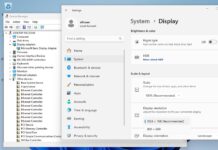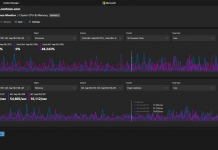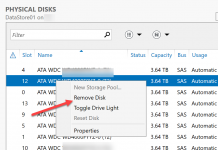Recently Microsoft announced that Windows Home Server will not see another version and is effectively discontinued. I actually think this makes a lot of sense, as I always felt that once the new drive extender technology was removed from Windows Home Server 2011 the product line was essentially doomed. Personally, I still have a production Windows Home Server V1 machine running, but only ended up implementing a test system for Windows Home Server 2011. Here are my thoughts on why Windows Home Server is headed to extinction. Reason #1: Microsoft failed on evangelizing the platform. Here is the issue, Microsoft never pushed any features from WHS seriously. It relied upon its OEM partners to generate buzz. When did you ever see Microsoft put out months worth of cool use-cases for WHS on YouTube? Sure there was some effort, but low marketing budget with no evangelist failed to solve a problem.
Reason #2: OEM partners had weak offerings. HP did a good job adding some custom functionality, but here is the thing, offerings were weak. 4-5 drive max capacity left OEM partners competing against the low-end Linux offerings yet requiring the overhead of Windows both in terms of hardware requirements and expense.
Reason #3: Microsoft did not tie the product into its ecosystem. I have absolutely no idea, other than organizational pressures, why Microsoft never made an attempt to do things such as Zune tie-ins and application virtualization/ site licensing. Here’s a cool use idea: Use an old PC or one from our OEM partners as your WHS and get Office for the entire family plus a redundant space for computer back-ups, purchased media, important shared file storage and etc. If you look at Google or Apple, they try to introduce products that integrate with the rest of their ecosystems. Microsoft needs to rely upon more than simply the fact that it is a Windows machine because users are not used to having a PC sitting around that nobody uses as a workstation.
Reason #4: Low-end shared storage is going away. Microsoft has the correct idea basically using all computers on the home network as potential storage devices. If a backup is needed, might as well use Storage Spaces.
Reason #5: With Storage Spaces, and basically Drive Extender V2 pre-installed with Windows 8, what else did Windows Home Server have to offer? Windows 8 is the new Windows Home Server because the feature dilution was too bad. Why make another SKU? With no unique features over the new standard Windows installation, and with anything one wanted to add being available through standard Windows software, what could Windows Home Server offer… that brings me to reason #6.
Reason #6: Where was feature development? If you look at mobile these days, there is constant innovation in features being offered with every iOS and Android launch. Menus are better, new functionality is added, and etc. Home users are accustomed to this type of constant innovation. Microsoft released Windows Home Server, but failed to keep adding new features.
Reason #7: The business model was flawed. If one recalls to the early days of WHS, it was only available by purchasing a system from an OEM partner. What Microsoft could have done is said: Here is Windows you can download for a USB flash drive that turns an old PC or laptop into a storage server with a bunch of features. We will charge you for the features you consume and here are a bunch of value added features. Note – this is really the same idea as we see with cloud based offerings but is a pricing model Microsoft is not overly comfortable with.
Reason #8: WHS 2011 basically required the use of an external RAID solution. Many options came out of the lack of DE V2, such as FlexRAID, using hardware RAID controllers and making a ZFS or linux based storage system exported via iSCSI in a virtual machine, but let’s face it, those are all much harder than simply plugging drives in and having everything work. Also, all three of those options are a lot harder than WHS V1’s setup and if you are going to invest the time and/ or money required to make a real storage server with WHS 2011, you probably are not far off from using FreeNAS, Amahi, OpenFiler or others. You cannot make things expensive or hard then say it is a home use product. People went to WHS V1 because it was easier to administer than looking things up constantly for a Linux box and less expensive than using a $500 RAID card.
Reason #9: Combining the above, what Microsoft lost was passion around the product. I still remember the buzz around the WHS 2011 Drive Extender V2. I also remember how disappointed folks were with the feature’s removal. Streaming media in WHS 2011 was great, but by the time you got media to the server, it was easy to stream with third party tools. FreeNAS offered better data protection. With Windows 8, Microsoft figured out that it needed some new feature/ functionality to get buzz. Windows Home Server lost the fight for differentiation and lost interest.
So those are my general thoughts on why Windows Home Server is going away. Feel free to add yours on the forums.




WHS is no longer because of the reasons you mentioned. No followup support and no killer features.
Good thing you didn’t put whs in your domain name.
I think you are underestimating the influence of Microsoft’s cloud strategy. If you go back and look for a common theme among all of Microsoft’s new products, you will see they are putting all their money on the the cloud. WHS isn’t part of the big picture because just about everything it was designed to do out of the box can easily be done in the cloud. Not only will the cloud offer a better solution for consumers (more accessible, less maintenance, etc) but it also means perpetual income for Microsoft. MS believes all small IT infrastructures are dead, hence why they killed SBS after all these years.
@ Ben The big issue you’re overlooking is this all depends on an internet connection. I know people who are still stuck with dial-up. Let’s see a computer being backed with that! Also it’s not nice to stream over dial-up so if you did finally get all of your media out to SkyDrive then it would suck.
And yes people, there are a lot of people stuck with dial-up.
Cloud is not a direct replacement. Do you have any idea how long it takes to restore 500GB of data on a desktop PC over a 1.5mbps connection? One PC goes down and the rest of the office is impacted. Especially if you are using a VoIP solution in a small business or at home.
I agree with most of your reasons – except for reason #5.
WHS has a simple to use, elegant and efficient centralized backup mechanism for client PCs. It’s far more effective than juggling multiple PCs each with their own silo backup application.
Even the introduction of File History in Windows 8 is not a proper replacement for what WHS has.
The one limitation of the WHS centralized backup is that it cannot backup/restore client PCs using EFI/GPT technology. If that were to be fixed, I’d simply carry on using WHS 2011 until end of life.